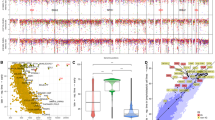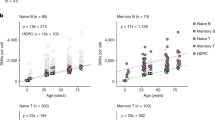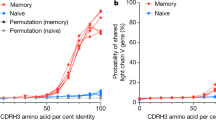Abstract
It is well established that B lymphocytes can achieve an almost unlimited antibody repertoire by using combinations of at least three different basic mechanisms1. First, the mammalian genome has multiple, distinct germline variable (V), joining (J) and diversity (D) gene segments which can presumably combine randomly to give V–D–J joins in the heavy (H)-chain loci and V–J joins in the light (L)-chain loci during the formation of functional antibody genes. Second, the actual joining points between any two combining gene segments can vary considerably, increasing the germline diversity. Further variability is generated in the heavy-chain locus by de novo addition of extra nucleotides between the combining gene segments. Finally, somatic mutations independent from joining events can accumulate in V regions during the lifetime of B lymphocytes. Here we report that when V and J regions join in the formation of functional λ1 light-chain genes, ‘lethal’ out-of-frame joins can be compensated for by the deletion of nucleotides several bases upstream of the actual joining points; this generates small stretches of nucleotides in a new frame between the deletion and the V–J joining point, thus creating additional diversity in the third hypervariable regions of the mouse λ1 light chains.
This is a preview of subscription content, access via your institution
Access options
Subscribe to this journal
Receive 51 print issues and online access
$199.00 per year
only $3.90 per issue
Buy this article
- Purchase on SpringerLink
- Instant access to full article PDF
Prices may be subject to local taxes which are calculated during checkout
Similar content being viewed by others
References
Tonegawa, S. Nature 302, 575–581 (1983).
Freitas, A. A. & Coutinho, A. J. exp. Med. 154, 994–999 (1981).
Takemori, T. & Rajewsky, K. Eur. J. Immun. 11, 618–625 (1981).
Andersson, J., Coutinho, A. & Melchers, F. J. exp. Med. 147, 1744–1754 (1978).
Hozumi, N. et al. Proc. natn. Acad. Sci. U.S.A. 78, 7019–7023 (1981).
Köhler, G. & Milstein, C. Nature 256, 495–496 (1975).
Towbin, H., Staehlin, T. & Gordon, J. Proc. natn. Acad. Sci. U.S.A. 76, 4350–4354 (1979).
Bothwell, A. L. M. et al. Nature 298, 380–382 (1982).
Maniatis, T., Fritsch, E. F. & Sambrook, J. Molecular Cloning, A Laboratory Manual (1982).
Maxam, A. M. & Gilbert, W. Meth. Enzym. 65, 499–560 (1980).
Author information
Authors and Affiliations
Rights and permissions
About this article
Cite this article
Karjalainen, K., Coleclough, C. An unusual type of V–J joining diversifies the primary repertoire of mouse λ1 light chains. Nature 314, 544–546 (1985). https://doi.org/10.1038/314544a0
Received:
Accepted:
Issue date:
DOI: https://doi.org/10.1038/314544a0



